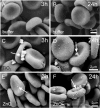Effect of engineered TiO2 and ZnO nanoparticles on erythrocytes, platelet-rich plasma and giant unilamelar phospholipid vesicles
- PMID: 23311901
- PMCID: PMC3549938
- DOI: 10.1186/1746-6148-9-7
Effect of engineered TiO2 and ZnO nanoparticles on erythrocytes, platelet-rich plasma and giant unilamelar phospholipid vesicles
Abstract
Background: Massive industrial production of engineered nanoparticles poses questions about health risks to living beings. In order to understand the underlying mechanisms, we studied the effects of TiO2 and ZnO agglomerated engineered nanoparticles (EPs) on erythrocytes, platelet-rich plasma and on suspensions of giant unilamelar phospholipid vesicles.
Results: Washed erythrocytes, platelet-rich plasma and suspensions of giant unilamelar phospholipid vesicles were incubated with samples of EPs. These samples were observed by different microscopic techniques. We found that TiO2 and ZnO EPs adhered to the membrane of washed human and canine erythrocytes. TiO2 and ZnO EPs induced coalescence of human erythrocytes. Addition of TiO2 and ZnO EPs to platelet-rich plasma caused activation of human platelets after 24 hours and 3 hours, respectively, while in canine erythrocytes, activation of platelets due to ZnO EPs occurred already after 1 hour. To assess the effect of EPs on a representative sample of giant unilamelar phospholipid vesicles, analysis of the recorded populations was improved by applying the principles of statistical physics. TiO2 EPs did not induce any notable effect on giant unilamelar phospholipid vesicles within 50 minutes of incubation, while ZnO EPs induced a decrease in the number of giant unilamelar phospholipid vesicles that was statistically significant (p < 0,001) already after 20 minutes of incubation.
Conclusions: These results indicate that TiO2 and ZnO EPs cause erythrocyte aggregation and could be potentially prothrombogenic, while ZnO could also cause membrane rupture.
Figures








Similar articles
-
Effect of carbon black nanomaterial on biological membranes revealed by shape of human erythrocytes, platelets and phospholipid vesicles.J Nanobiotechnology. 2015 Mar 28;13:28. doi: 10.1186/s12951-015-0087-3. J Nanobiotechnology. 2015. PMID: 25886274 Free PMC article.
-
Antimicrobial activity of ZnO-TiO2 nanomaterials synthesized from three different precursors of ZnO: influence of ZnO/TiO2 weight ratio.Water Sci Technol. 2018 Mar;77(5-6):1238-1249. doi: 10.2166/wst.2017.647. Water Sci Technol. 2018. PMID: 29528312
-
Evaluation of cytogenotoxicity and oxidative stress parameters in male Swiss mice co-exposed to titanium dioxide and zinc oxide nanoparticles.Environ Toxicol Pharmacol. 2019 Aug;70:103204. doi: 10.1016/j.etap.2019.103204. Epub 2019 Jun 5. Environ Toxicol Pharmacol. 2019. PMID: 31200344
-
Versatile Phospholipid Assemblies for Functional Synthetic Cells and Artificial Tissues.Adv Mater. 2021 Feb;33(6):e2002635. doi: 10.1002/adma.202002635. Epub 2020 Aug 23. Adv Mater. 2021. PMID: 32830387 Review.
-
Effects of Selected Metal Nanoparticles (Ag, ZnO, TiO2) on the Structure and Function of Reproductive Organs.Toxics. 2022 Aug 8;10(8):459. doi: 10.3390/toxics10080459. Toxics. 2022. PMID: 36006138 Free PMC article. Review.
Cited by
-
A double-edged sword: The complex interplay between engineered nanoparticles and platelets.Bioeng Transl Med. 2024 Apr 6;9(4):e10669. doi: 10.1002/btm2.10669. eCollection 2024 Jul. Bioeng Transl Med. 2024. PMID: 39036095 Free PMC article. Review.
-
Effect on Platelet Function of Metal-Based Nanoparticles Developed for Medical Applications.Front Cardiovasc Med. 2019 Sep 18;6:139. doi: 10.3389/fcvm.2019.00139. eCollection 2019. Front Cardiovasc Med. 2019. PMID: 31620449 Free PMC article. Review.
-
Effect of carbon black nanomaterial on biological membranes revealed by shape of human erythrocytes, platelets and phospholipid vesicles.J Nanobiotechnology. 2015 Mar 28;13:28. doi: 10.1186/s12951-015-0087-3. J Nanobiotechnology. 2015. PMID: 25886274 Free PMC article.
-
Varying Doses of Rare-Earth-Metal-Based Neodymium Zirconate Zinc Sulfide Nanocomposite Disrupt Blood and Serum Parameters, as well as Markers of Oxidative Stress in the Selected Organs of Albino Mice.Genes (Basel). 2022 Dec 1;13(12):2262. doi: 10.3390/genes13122262. Genes (Basel). 2022. PMID: 36553529 Free PMC article.
-
Effects of magnetic cobalt ferrite nanoparticles on biological and artificial lipid membranes.Int J Nanomedicine. 2014 Mar 27;9:1559-81. doi: 10.2147/IJN.S57671. eCollection 2014. Int J Nanomedicine. 2014. PMID: 24741305 Free PMC article.
References
-
- Colvin V. The potential environmental impact of engineered nanomaterials. Nat Biotechnol. 2003;13:1166–1170. - PubMed
-
- Iavicoli I, Leso V, Fontana L, Bergamaschi A. Toxicological effects of titanium dioxide nanoparticles: a review of in vitro mammalian studies. Eur Rev Med Pharmaco. 2011;15:481–508. - PubMed
-
- Reijnders L. Human health hazards of persistent inorganic and carbon nanoparticles. J Mater Sci. 2012;47:5061–5073. doi: 10.1007/s10853-012-6288-3. - DOI
MeSH terms
Substances
LinkOut - more resources
Full Text Sources
Other Literature Sources

